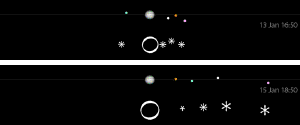Post
Moons of Galileo
20 July 2013
 Ernie Wright
Ernie WrightIn the first few months of 1610, Galileo Galilei pointed a small twenty-power telescope at Jupiter. What he observed changed the way we understood the universe.
With his telescope, Galileo saw what appeared to be three faint stars in a straight line near Jupiter. The next evening he saw what appeared to be the same three stars, but it seemed Jupiter had moved in the opposite direction to its expected motion. Within a few days it became clear that Galileo wasn’t observing the motion of Jupiter relative to some faint stars, but rather these stars were moving along with Jupiter.
It also became clear that these weren’t stars at all. They didn’t twinkle the way stars do, which was a long known method of distinguishing planets from stars. Stellar twinkling occurs because of small disturbances our atmosphere. Stars are so distant that they appear as points of light, so the atmospheric disturbances bend and deflect the starlight, causing it to twinkle. Planets are close enough that they appear as a small disk. They are too small to resolve as a disk with the naked eye, but they are wide enough that atmospheric disturbances don’t cause them to twinkle.
Galileo knew they must be more like planets than stars, so over the next two months he watched their motion, making a total of 64 observations of their positions. He discovered a total of four objects moving about Jupiter. Sometimes he could observe all of them, and other times he only observed one or two. It was clear, however, that these objects were moving about Jupiter in the same way that the Moon moves about the Earth. Galileo had discovered four moons of Jupiter.
Galileo’s discovery of Jupiter’s moons confirmed that the geocentric view of the universe was wrong. Copernicus had proposed a Sun-centered view of the cosmos nearly 70 years earlier, but this heliocentric model was still controversial when Galileo made his observations. Many supporters of Copernicus were still careful to distinguish the apparent motion of the planets around the Sun from the claim that planets actually moved about the Sun.
Galileo’s moons clearly did not move about the Earth, but instead orbited a mere planet. In the Fall of 1610, Galileo observed that Venus exhibited phases consistent a motion about the Sun rather than the Earth, which further supported the heliocentric model. Of course, claiming that this was evidence that the Earth and other planets actually orbited the Sun famously led him into a bit of trouble with the Church, but that’s a different story.
Perhaps the most amazing aspect of Galileo’s discovery is just how accurate his observations were. Ernie Wright has made a detailed study of Galileo’s moons as they appear in his Sidereus Nuncius (Starry Messenger), comparing them with the actual positions of the moons at the times of Galileo’s observations. You can see two examples of these in the figure above. The agreement is surprisingly good, particularly when you consider that Galileo made his observations with freehand sketches while observing them through a telescope less powerful than a cheap pair of modern binoculars.
The precision of Galileo’s observations more than justifies calling these four moons the Galilean moons of Jupiter.